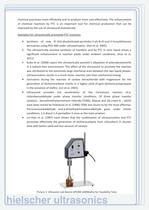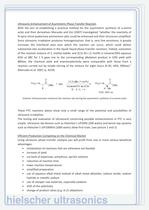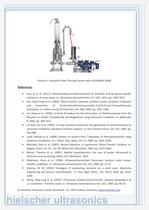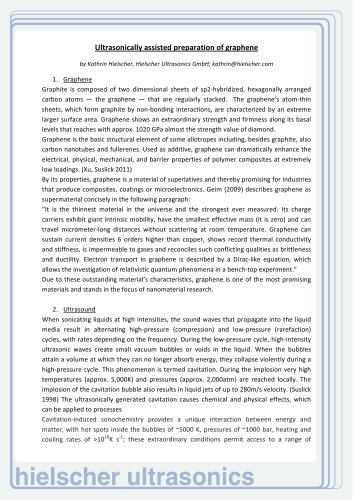
Catalog excerpts

Ultrasonically induced and enhanced Phase Transfer Catalysis Kathrin Hielscher, Hielscher Ultrasonics GmbH kathrin@hielscher.com; www.hielscher.com Phase Transfer Catalysis Phase Transfer Catalysis (PTC) is a special form of heterogeneous catalysis and known as a practical methodology for organic synthesis. By using a phase transfer catalyst, it becomes possible to solubilize ionic reactants, which are often soluble in an aqueous phase but insoluble in an organic phase. General advantages of phase transfer catalysis are the little efforts for preparation, simple experimental procedures, mild reaction conditions and the use of inexpensive and environmentally benign reagents, such as quaternary ammonium salts, and solvents, and the possibility of conducting large scale preparations (Ooi et al. 2007). A variety of liquid–liquid and liquid–solid reactions have been intensified and made selective by using simple phase-transfer (PT) catalysts such as quats, polyethylene glycol-400, etc., which allow ionic species to be ferried from aqueous phase to organic phase. Thus, the problems associated with extremely low solubility of the organic reactants in the aqueous phase can be overcome. In the pesticide and pharmaceutical industries, PTC is used extensively and has changed the fundamentals of business. (Sharma 2002) Power Ultrasound The application of power ultrasound is a well-known tool to create extremely fine emulsions. In chemistry such extremely fine-size emulsions are used to enhance chemical reactions. This means that the interfacial contact area between two or more immiscible liquids becomes dramatically enlarged and provides thereby a better, more complete and/or faster course of the reaction. For phase transfer catalysis - the same as for other chemical reactions – enough kinetic energy is needed to start the reaction. This has various positive effects regarding the chemical reaction: 1. A chemical reaction that will normally not occur because of its low kinetic energy can get started by ultrasonication. 2. Chemical reactions can be accelerated by ultrasonically-assisted PTC. 3. Complete avoidance of phase transfer catalyst. 4. Raw materials can be used more efficient. 5. By-products can be reduced. 6. Replacement of cost-intensive hazardous strong base with inexpensive inorganic base. By these effects, PTC is an invaluable chemical methodology for organic synthesis from two and more immiscible reactants: Phase transfer catalysis (PTC) enables to use raw material of
Open the catalog to page 1
chemical processes more efficiently and to produce more cost-effectively. The enhancement of chemical reactions by PTC is an important tool for chemical production that can be improved by the use of ultrasound dramatically. Examples for ultrasonically promoted PTC reactions • • Synthesis of new N'-(4,6-disubstituted-pyrimidin-2-yl)-N-(5-aryl-2-furoyl)thiourea derivatives using PEG-400 under ultrasonication. (Ken et al. 2005) The ultrasonically assisted synthesis of mandelic acid by PTC in ionic liquid shows a significant enhancement in reaction yields under ambient conditions. (Hua et al....
Open the catalog to page 2
Ultrasonic Enhancement of Asymmetric Phase Transfer Reaction With the aim of establishing a practical method for the asymmetric synthesis of a-amino acids and their derivatives Maruoka and Ooi (2007) investigated “whether the reactivity of N-spiro chiral quaternary ammonium salts could be enhanced and their structures simplified. Since ultrasonic irradiation produces homogenization, that is, very fine emulsions, it greatly increases the interfacial area over which the reaction can occur, which could deliver substantial rate acceleration in the liquid–liquid phase-transfer reactions. Indeed,...
Open the catalog to page 3
simplified isolation and purification increase of the yield by suppressing side reactions simple, linear scale-up to industrial production level, even with very high throughput Simple and risk-free testing of Ultrasonic Effects in Chemistry To see how ultrasound influences specific materials and reactions, first feasibility tests can be conducted in small scale. Hand-held or stand-mounted laboratory devices in the range of 50 to 400 watts allow for sonication of small- and mid-size samples in the beaker. If the first results show potential achievements, the process can developed and...
Open the catalog to page 4
Picture 2: Ultrasonic Flow-Through System with UIP1000hd (1kW) Hua, Q. et al. (2011): Ultrasonically-promoted synthesis of mandelic acid by phase transfer catalysis in an ionic liquid. In: Ultrasonics Sonochemistry Vol. 18/5, 2011; pp. 1035-1037. Ken, Shao-Yong et al. (2005): Phase transfer catalyzed synthesis under ultrasonic irradiation and bioactivity of N'-(4,6-disubstituted-pyrimidin-2-yl)-N-(5-aryl-2-furoyl)thiourea derivatives. In: Indian Journal of Chemistry Vol. 44B, 2005; pp. 1957-1960. Lin, Haixa et al. (2003): A Facile Procedure for the Generation of Dichlorocarbene from the...
Open the catalog to page 5All Hielscher catalogs and technical brochures
-
Ultrasonic Process Lab
1 Pages
-
Ultrasonic Wire Cleaning
4 Pages
-
Ultrasonic Applications
1 Pages
-
Hielscher Ultrasonic Sieves
2 Pages



















